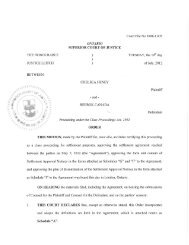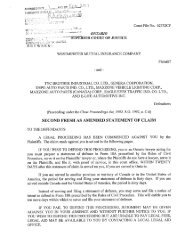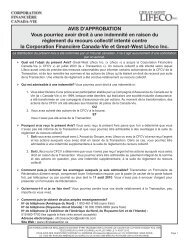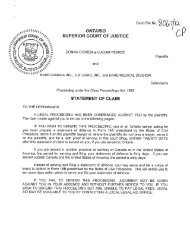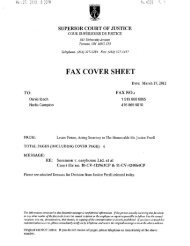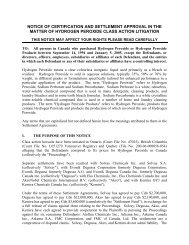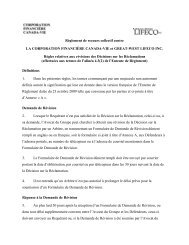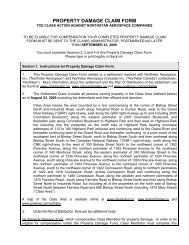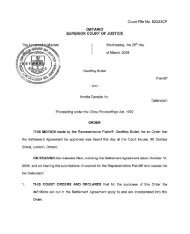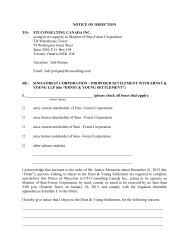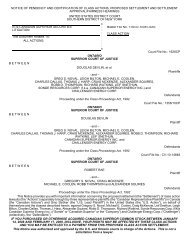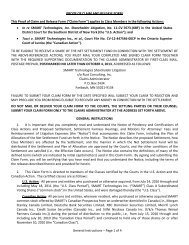Gariepy v. Shell Oil Co. - Classaction.ca
Gariepy v. Shell Oil Co. - Classaction.ca
Gariepy v. Shell Oil Co. - Classaction.ca
Create successful ePaper yourself
Turn your PDF publications into a flip-book with our unique Google optimized e-Paper software.
Canadian Shopping Centre Inc. v. Dutton (2001), 201 D.L.R. (4th) 385 (S.C.C.) where Chief JusticeMcLachlin said, at p. 401:"First, the class must be <strong>ca</strong>pable of clear definition. Class definition is criti<strong>ca</strong>lbe<strong>ca</strong>use it identifies the individuals entitled to notice, entitled to relief (if relief isawarded), and bound by the judgment. It is essential, therefore, that the class bedefined clearly at the outset of the litigation. The definition should state objectivecriteria by which members of the class <strong>ca</strong>n be identified. While the criteria shouldbear a rational relationship to the common issues asserted by all class members, thecriteria should not depend on the outcome of the litigation. It is not necessary thatevery class member be named or known." 47 Although not expressly stated by the Chief Justice, a clearly defined class is also required inorder that persons will know if they are members of the class so that they may, in turn, decide if theywish to have their rights determined within the class proceeding, or if they would prefer to opt outof the class proceeding and have their rights determined in another fashion, or not at all. It isextremely important, therefore, that the class definition be one where any person <strong>ca</strong>n tell, with aminimum of effort, whether he or she is a member of the proposed class. 48 This requirement is met with respect to <strong>Shell</strong> be<strong>ca</strong>use, as I have noted, the homeowner onlyneeds to look at the pipes to determine if they are polybutylene pipes. The fittings are, however,another matter. It does not provide a clearly identifiable class if each homeowner is required to havethe fittings removed from their plumbing systems and chemi<strong>ca</strong>lly tested in order to determine if thefittings are ones covered by the claims advanced. There is no evidence before me as to the costs ofremoving and testing these fixtures but, in any event, it would seem unlikely that, absent an existingproblem with the plumbing system, any homeowner would be prepared to go through the expenseand inconvenience of having such testing done nor should they be required to do so in order todetermine if they are part of this action and, if so, whether they wish to have their rights dealt within this action. 49 It is possible that the problem regarding the identifiable class for Celanese could be dealt withby narrowing the definition of the class to include only those fittings manufactured by specificmanufacturers and that are clearly marked. There are two difficulties with that approach, however.First, it is not clear on the evidence that it is beyond doubt that any particular manufacturer usedonly Celcon to manufacture its fittings (although there is a fair belief that one manufacturer, Qest,may fall into that <strong>ca</strong>tegory). Second, amending the class definition in such a fashion, runs the riskof being arbitrary in its result by including only some who have a claim while excluding others whomay also have a claim. I earlier mentioned the difficulty of a class definition that was overlyinclusive. It seems to me that a class definition which is arbitrarily under inclusive is equallyproblematic. 50 I conclude therefore that the requirement that there be an identifiable class is satisfied withrespect to <strong>Shell</strong> but that it is not with respect to Celanese.C. <strong>Co</strong>mmon Issues 51 The common issues, as stated by the plaintiffs in their factum, are:



